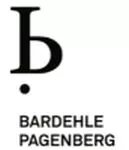- within Intellectual Property topic(s)
- in United States
- with readers working within the Law Firm industries
After more than two years of UPC case law, the sample size of UPC decisions justifies a first UPC Fact Check. Of course, any fact check is only a snapshot as the UPC case law is constantly evolving and many of the cases decided by the UPC Court of First Instance (CFI) are currently pending on appeal where they await their final determination. In any case: numbers don't lie and the current UPC statistics are telling! This is true both for infringement and for revocation actions, as will be detailed below:
1. Infringement proceedings
1.1 Success rates in main actions
The preamble of the Agreement on the Unified Patent Court stipulates that the court shall be devised to ensure expeditious and high-quality decisions having regard to a fair balance between the interests of right holders and other parties. That said, the UPC is set up to be a balanced court.
With this mission statement of the UPC in mind, the current success rates for main actions do not come as a surprise: based on the data available as of August 31, 2025, plaintiffs were successful in 51% of the cases and unsuccessful in the remaining 49%.
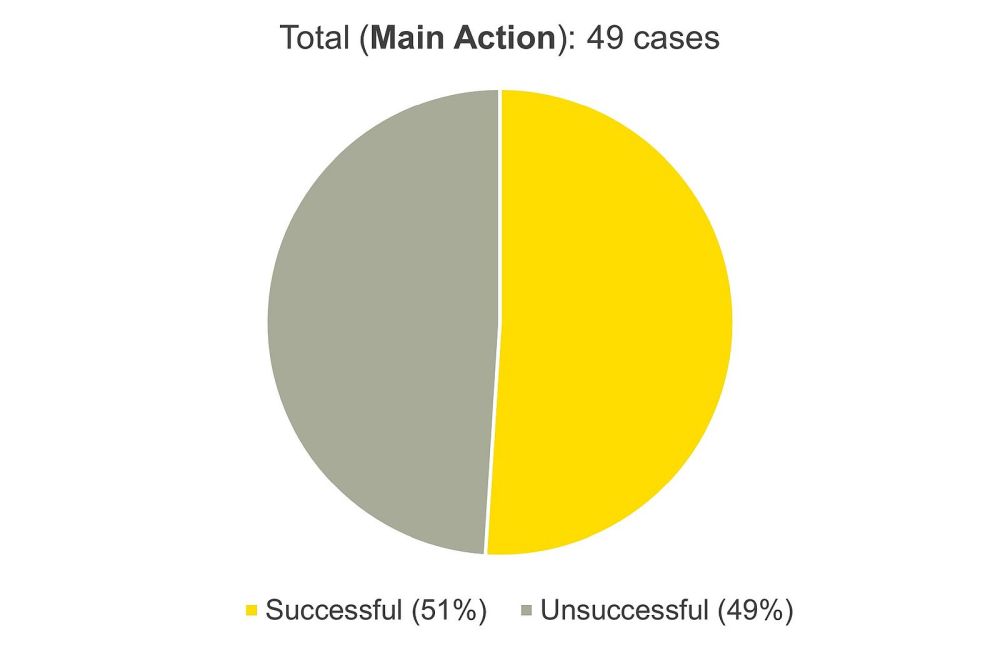
Success means that the UPC issued the requested relief which
presupposes that the patent-in-suit was deemed valid and
infringed.
1.2 Success rates in preliminary injunctions (PI)
As the success rates for main actions do not really come as a surprise, this is different when looking at the outcome of the decisions in relation to preliminary injunctions. In this category, patentees were even more successful than in main actions (55% win rate).
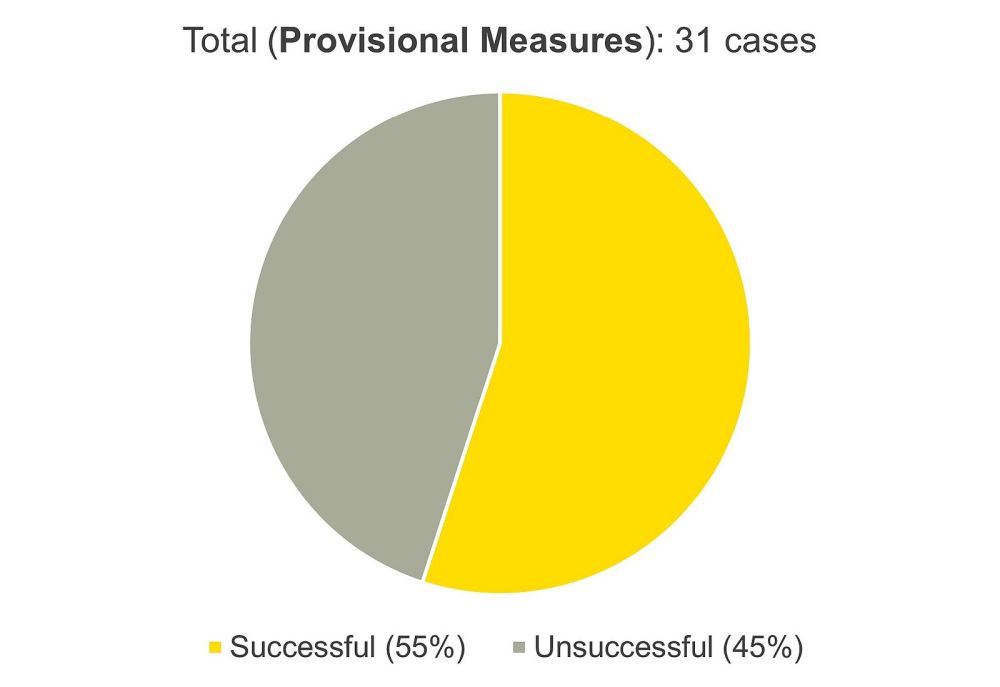
Under the UPC Rules of Procedure, these fast-track proceedings are designed as a separate track from main proceedings. In practice, this fast track can be superfast, as decisions may be rendered within a day (in cases of trade shows) or at least 10–16 weeks in case of a standard PI case. In practice, the standard PI case is fought like a main action which provides an explanation of the statistics, since it provides the Court with the necessary comfort that the facts are on the table and that a balanced and equitable decision can be made.
1.3 Value of the actions (value in dispute)
After the first two years of the UPC, a trend has emerged which can be characterized as a court system of moderate values in dispute (this applies both to infringement actions and central revocation actions). The value in dispute has a direct impact on calculating the court fees and the recoverable attorney fees under the "UPC's loser pays system". That said moderate values in dispute mean affordable entrance tickets for UPC proceedings and manageable cost risks. When turning to the UPC statistics, the vast majority of cases had a value in dispute of between EUR 500k–EUR 5 million, being tantamount to court fees of EUR 11k–EUR 43k as well as recoverable attorney fees of EUR 56k–EUR 600k.
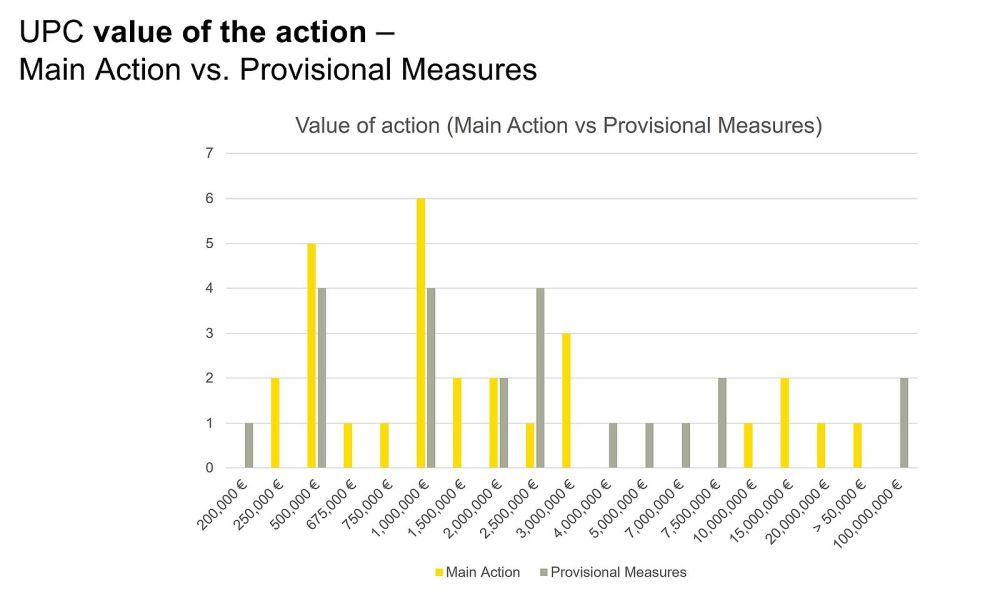
1.4 Enforcement security
Under the UPC system (Rule 352 RoP), decisions and orders may be subject to the rendering of a "security" (whether by deposit, bank guarantee or otherwise). This "security" shall compensate the losing party for any damage incurred or likely to be incurred if the decisions and orders are enforced and subsequently revoked. For UPC defendants, high enforcement securities are an important defense shield in case first-instance proceedings are lost (since the higher the financial enforcement stakes, the more likely it becomes that right holders wait for the final determination by the Court of Appeal).
However, for main actions this shield is rarely available as in 88% of all UPC decisions on the merits no enforcement security was ordered. In preliminary injunction cases, the situation is different. Here, in 47% of all cases, an enforcement security was ordered. Still, from a defendant's perspective, this number is also rather low, bearing in mind that a decision was made in summary proceedings.
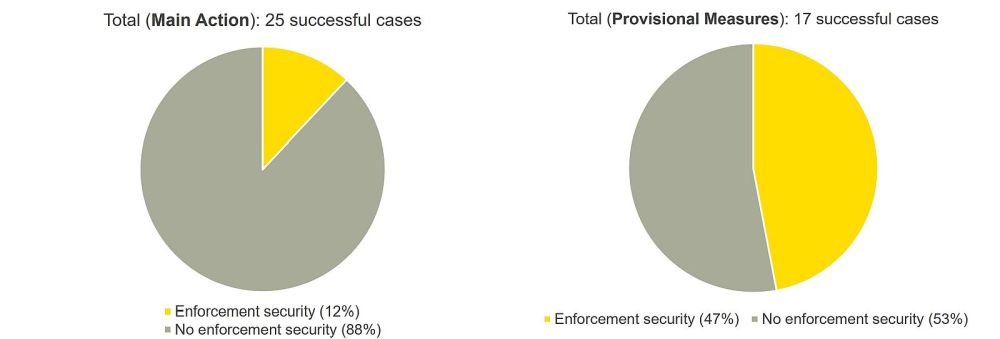
2. Revocation
The UPC offers new possibilities to challenge the validity of patents – in parallel to already existing attacks before the EPO and national courts. These new options can significantly impact enforcement campaigns and entail risks concerning validity, costs, and liability (in situations where a non-final injunction is enforced and the patent-in-suit is later on invalidated).
A significant risk for patentees lies in the possibility of combining a central revocation action, a counterclaim for revocation, national revocation proceedings (for European bundle patents), and opposition proceedings before the EPO. But is it advisable to raise multiple validity challenges in parallel from a defendant's perspective? In this regard, the following statistics (as of August 31, 2025) offer helpful guidance even though the sample size is, for the time being, still low:
2.1 Revocation rates
The chances for the patent owner to defend the patent with the scope as granted at the UPC are significantly lower before the Central Division for central revocation actions (26%) than for counterclaims for revocation before the Local Divisions (44%).
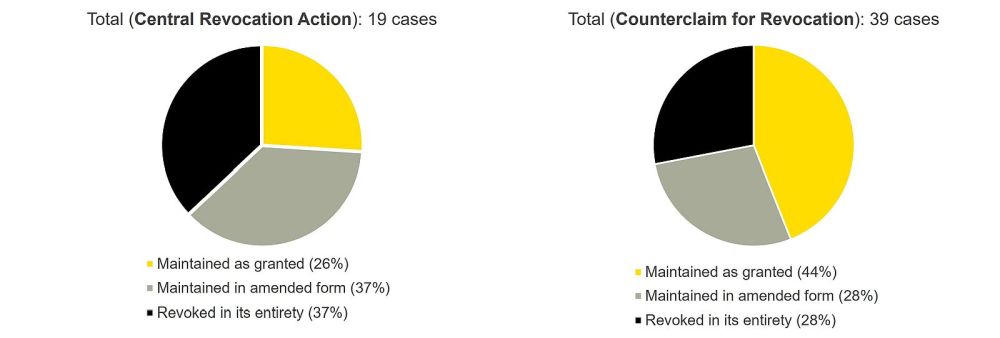
In addition, there are notable differences between the various Central and Local/Regional Divisions with respect to the revocation rates. The Central Division in Paris has upheld patents either as granted or in amended form in 71% of the cases and only fully revoked the patent in less than 30% of the cases. By contrast, the Central Division in Munich has fully revoked the patent-in-suit in both of the cases it has decided so far. However, the data from the Central Division in Munich is not very reliable, as only two cases have been decided to date. It is self-evident that the Munich Central Division will not revoke all patents in the future, but its early decisions suggest a stricter approach to obviousness compared to the Paris Central Division.
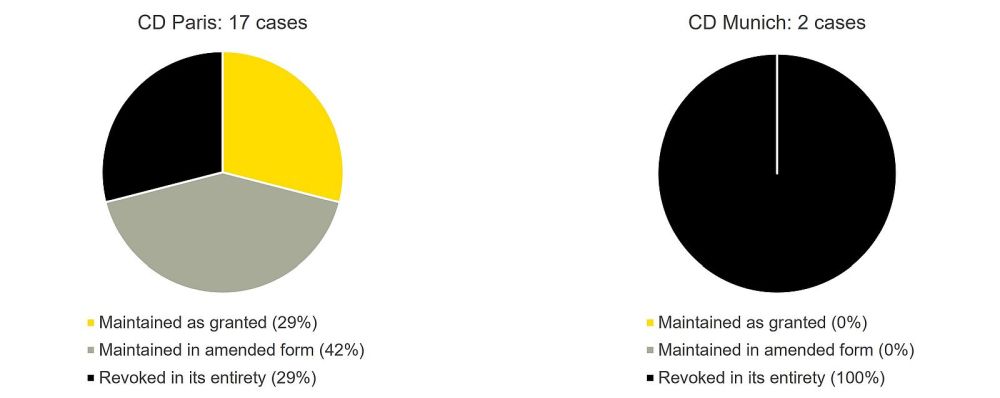
The Local and Regional Divisions of the UPC also present a varied landscape. While the Local Divisions in Munich (22%), Düsseldorf (20%), Hamburg (0%), The Hague (0%) and the Nordic-Baltic Regional Division (0%) fully revoke patents in only a small percentage of cases, the Local Divisions in Mannheim (33%) and especially Paris (83%) revoke a significantly higher proportion, with Paris even revoking the majority of patents.
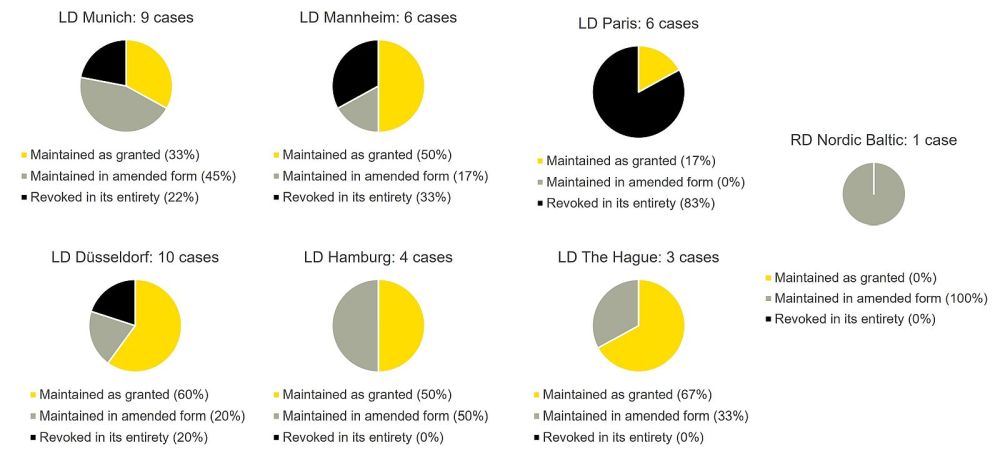
Comparison of revocation rates at UPC, EPO and FPC
Compared with the UPC, attacks on patents prove even more successful in EPO oppositions or German national revocation proceedings, where only 21% (EPO) or 14% (Germany) of the patents are maintained as granted in first-instance proceedings.
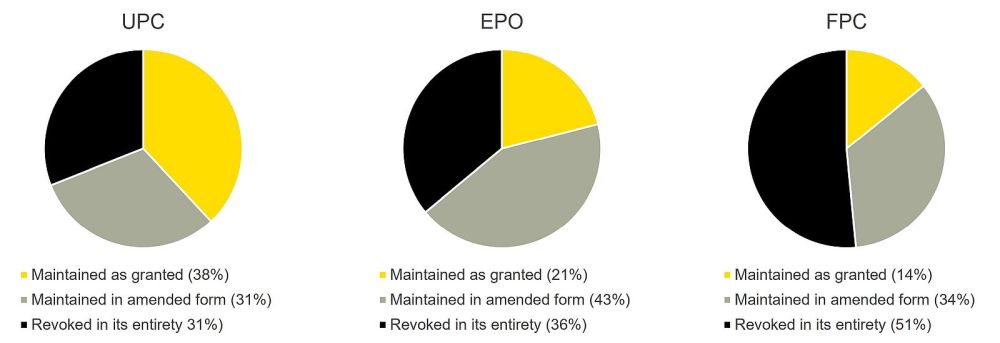
2.2 Grounds for revocation
In both Central Revocation Actions (57%) and Counterclaims for Revocation (50%), the primary ground for revocation is lack of patentability. However, added subject-matter issues also play a significant and noteworthy role, accounting for 43% of the revocation cases (complete and partial revocation) at the Central Divisions and 45% at the Local/Regional Divisions.

Comparison of grounds for revocation at the UPC and FPC
Before the UPC (Central and Local/Regional Divisions), "only" 53% of all (complete and partial) revocations were based on lack of patentability, and 44% on added subject-matter, whereas in German national revocation proceedings, 87% of all (complete and partial) revocations were based on lack of patentability, and only 12% on added subject-matter.
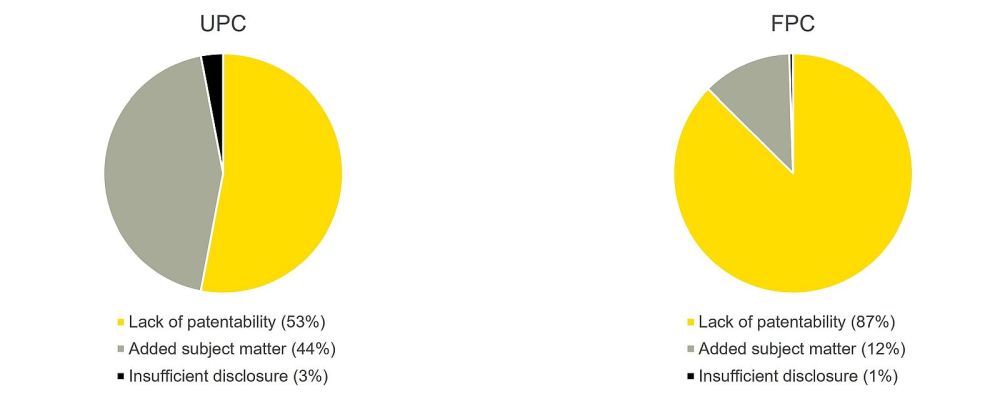
Depending on whether the revocation plaintiff considers the strength of its case to lie more in the lack of patentability or in issues of added subject-matter, it may be strategically advantageous (if feasible) to go for the UPC rather than the FPC, or vice versa. Of course, from a strategic perspective it is worthwhile getting multiple bites at the invalidity apple making parallel invalidity attacks an interesting option.
What happens if the UPC and EPO reach different decisions on the validity of a patent in parallel proceedings?
Parallel revocation/opposition proceedings before the UPC and the EPO can lead to differing decisions regarding the validity of a patent. Below, we outline three key scenarios, with the first two referred to under the concept of "one bullet kills" (Court of Appeal 28 May 2024, APL_3507/2024, UPC_CoA_22/2024, Carrier/BITZER, par. 25):
Scenario 1: EPO revokes the patent, UPC maintains it
If the EPO fully revokes the patent while the UPC maintains it as granted or in amended form, the UPC's decision becomes void. This is because the EPO's revocation applies with retroactive effect for all of the 39 EPC Member States which include the 18 UPC Member States meaning the patent is considered never to have been granted.
Scenario 2: UPC revokes the patent, EPO maintains it
In this case, the patent is considered revoked for the UPC Member States, while it remains valid in the non-UPC Member States of the EPC in the scope upheld by the EPO. This creates a fragmented legal status for the patent across jurisdictions.
Scenario 3: UPC and EPO maintain patent in different form
If the UPC maintains the patent with a different scope than the EPO does in opposition proceedings, the following may apply: For EPC Member States that are not part of the UPC territory, the patent will be valid in the scope maintained by the EPO (the UPC decision has no impact on these states as they are not under the UPC's jurisdiction). For UPC member states, the scope of the patent is limited by both the limitations required by the EPO and by the UPC (principle of double-limitation). In other words: such a patent is only infringed in the territory of the UPC if the accused product realizes such limitations as requested by the EPO and those further limitations as requested by the UPC.
These scenarios highlight the complexities and potential inconsistencies that can arise from parallel proceedings. For patentees and revocation plaintiffs/opponents alike, understanding the interplay between UPC and EPO is crucial for navigating the patent landscape effectively.
3. A glimpse into the future: Analysis of the Court of Appeal (CoA)
As of today, we are still waiting for the first decisions of the CoA in proceedings on the merits. This applies both to infringement and central revocation actions. However, the decisions which the CoA rendered in the past two years in preliminary injunction proceedings already dealt with both the most fundamental questions of patent law – claim construction, novelty, obviousness and added subject-matter (cf. UPC_CoA_335/2023, order of 26 February 2024, 10X vs NanoString and UPC_CoA_382/2024, order of 14 February 2025, Abbott vs Sibio) – as well as with procedural aspects like the need to provide litigation securities (UPC_CoA_217/2024, order of 17 September 2024, Audi vs Network System Technologies LLC).
The findings of these CoA decisions are already incorporated in the current case law of the Court of First Instance. In light of this, it is fair to assume that the success and revocation rates for CoA will not significantly differ from the ones that we currently see at the Court of First Instance. However, insofar as EPO opposition proceedings were commenced in parallel, the final outcome of UPC campaigns hinges on the decision-making of this body. From a user's perspective, it is desirable that a harmonization of UPC and EPO case law will take place over the upcoming years. First steps towards harmonization have already been made on both sides (cf. UPC_CFI 501/2023, decision of 4 April 2025, Edwards vs Meril and Enlarged Board of Appeal, decision of 18 June 2025, G1/24) and further ones will likely be made, sooner than later.
The content of this article is intended to provide a general guide to the subject matter. Specialist advice should be sought about your specific circumstances.
[View Source]
